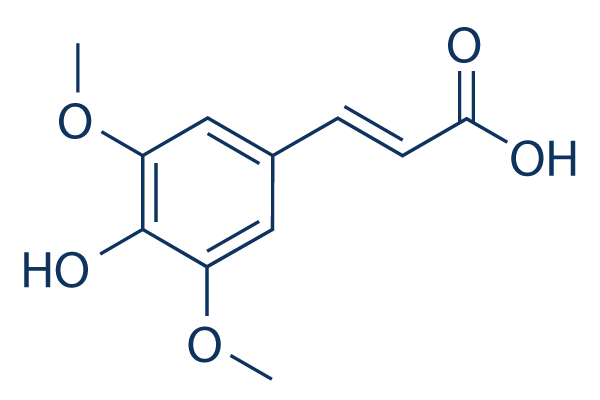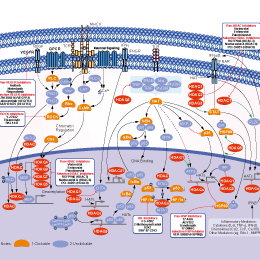
- Bioactive Compounds
- By Signaling Pathways
- PI3K/Akt/mTOR
- Epigenetics
- Methylation
- Immunology & Inflammation
- Protein Tyrosine Kinase
- Angiogenesis
- Apoptosis
- Autophagy
- ER stress & UPR
- JAK/STAT
- MAPK
- Cytoskeletal Signaling
- Cell Cycle
- TGF-beta/Smad
- DNA Damage/DNA Repair
- Compound Libraries
- Popular Compound Libraries
- Customize Library
- Clinical and FDA-approved Related
- Bioactive Compound Libraries
- Inhibitor Related
- Natural Product Related
- Metabolism Related
- Cell Death Related
- By Signaling Pathway
- By Disease
- Anti-infection and Antiviral Related
- Neuronal and Immunology Related
- Fragment and Covalent Related
- FDA-approved Drug Library
- FDA-approved & Passed Phase I Drug Library
- Preclinical/Clinical Compound Library
- Bioactive Compound Library-I
- Bioactive Compound Library-Ⅱ
- Kinase Inhibitor Library
- Express-Pick Library
- Natural Product Library
- Human Endogenous Metabolite Compound Library
- Alkaloid Compound LibraryNew
- Angiogenesis Related compound Library
- Anti-Aging Compound Library
- Anti-alzheimer Disease Compound Library
- Antibiotics compound Library
- Anti-cancer Compound Library
- Anti-cancer Compound Library-Ⅱ
- Anti-cancer Metabolism Compound Library
- Anti-Cardiovascular Disease Compound Library
- Anti-diabetic Compound Library
- Anti-infection Compound Library
- Antioxidant Compound Library
- Anti-parasitic Compound Library
- Antiviral Compound Library
- Apoptosis Compound Library
- Autophagy Compound Library
- Calcium Channel Blocker LibraryNew
- Cambridge Cancer Compound Library
- Carbohydrate Metabolism Compound LibraryNew
- Cell Cycle compound library
- CNS-Penetrant Compound Library
- Covalent Inhibitor Library
- Cytokine Inhibitor LibraryNew
- Cytoskeletal Signaling Pathway Compound Library
- DNA Damage/DNA Repair compound Library
- Drug-like Compound Library
- Endoplasmic Reticulum Stress Compound Library
- Epigenetics Compound Library
- Exosome Secretion Related Compound LibraryNew
- FDA-approved Anticancer Drug LibraryNew
- Ferroptosis Compound Library
- Flavonoid Compound Library
- Fragment Library
- Glutamine Metabolism Compound Library
- Glycolysis Compound Library
- GPCR Compound Library
- Gut Microbial Metabolite Library
- HIF-1 Signaling Pathway Compound Library
- Highly Selective Inhibitor Library
- Histone modification compound library
- HTS Library for Drug Discovery
- Human Hormone Related Compound LibraryNew
- Human Transcription Factor Compound LibraryNew
- Immunology/Inflammation Compound Library
- Inhibitor Library
- Ion Channel Ligand Library
- JAK/STAT compound library
- Lipid Metabolism Compound LibraryNew
- Macrocyclic Compound Library
- MAPK Inhibitor Library
- Medicine Food Homology Compound Library
- Metabolism Compound Library
- Methylation Compound Library
- Mouse Metabolite Compound LibraryNew
- Natural Organic Compound Library
- Neuronal Signaling Compound Library
- NF-κB Signaling Compound Library
- Nucleoside Analogue Library
- Obesity Compound Library
- Oxidative Stress Compound LibraryNew
- Plant Extract Library
- Phenotypic Screening Library
- PI3K/Akt Inhibitor Library
- Protease Inhibitor Library
- Protein-protein Interaction Inhibitor Library
- Pyroptosis Compound Library
- Small Molecule Immuno-Oncology Compound Library
- Mitochondria-Targeted Compound LibraryNew
- Stem Cell Differentiation Compound LibraryNew
- Stem Cell Signaling Compound Library
- Natural Phenol Compound LibraryNew
- Natural Terpenoid Compound LibraryNew
- TGF-beta/Smad compound library
- Traditional Chinese Medicine Library
- Tyrosine Kinase Inhibitor Library
- Ubiquitination Compound Library
-
Cherry Picking
You can personalize your library with chemicals from within Selleck's inventory. Build the right library for your research endeavors by choosing from compounds in all of our available libraries.
Please contact us at info@selleckchem.com to customize your library.
You could select:
- Antibodies
- Bioreagents
- qPCR
- 2x SYBR Green qPCR Master Mix
- 2x SYBR Green qPCR Master Mix(Low ROX)
- 2x SYBR Green qPCR Master Mix(High ROX)
- Protein Assay
- Protein A/G Magnetic Beads for IP
- Anti-Flag magnetic beads
- Anti-Flag Affinity Gel
- Anti-Myc magnetic beads
- Anti-HA magnetic beads
- Poly DYKDDDDK Tag Peptide lyophilized powder
- Protease Inhibitor Cocktail
- Protease Inhibitor Cocktail (EDTA-Free, 100X in DMSO)
- Phosphatase Inhibitor Cocktail (2 Tubes, 100X)
- Cell Biology
- Cell Counting Kit-8 (CCK-8)
- Animal Experiment
- Mouse Direct PCR Kit (For Genotyping)
- New Products
- Contact Us
research use only
Sinapinic Acid HDAC inhibitor
Sinapinic acid (Sinapic acid) is a small naturally occurring hydroxycinnamic acid which belongs to phenylpropanoid family and commonly used as matrix in MALDI mass spectrometry. Sinapinic acid (Sinapic acid) acts as an inhibitor of HDAC, with IC50 of 2.27 mM, and also inhibits ACE-I activity.

Chemical Structure
Molecular Weight: 224.21
Purity & Quality Control
Batch:
S398101
DMSO]44 mg/mL]false]Ethanol]44 mg/mL]false]Water]Insoluble]false
Purity:
99.9%
99.9
Related Products
| Related Targets | HDAC1 HDAC2 HDAC3 HDAC4 HDAC5 HDAC6 HDAC7 HDAC8 HDAC9 HDAC10 HDAC11 HD1 HD2 | Click to Expand |
|---|---|---|
| Related Products | Entinostat (MS-275) TSA (Trichostatin A) Mocetinostat (MGCD0103) RGFP966 Tubastatin A Ricolinostat (ACY-1215) Quisinostat (JNJ-26481585) 2HCl MC1568 Tubastatin A HCl PCI-34051 Tacedinaline (CI994) LMK-235 Fimepinostat (CUDC-907) Tubacin Givinostat hydrochloride monohydrate TMP269 AR-42 Sodium butyrate Pracinostat (SB939) Santacruzamate A (CAY10683) | Click to Expand |
| Related Compound Libraries | FDA-approved Drug Library Natural Product Library Apoptosis Compound Library DNA Damage/DNA Repair compound Library Cell Cycle compound library | Click to Expand |
Signaling Pathway
Mechanism of Action
| Targets |
|
|---|
In vitro |
||||
| In vitro | Sinapic acid is widespread in the plant kingdom (fruits, vegetables, cereal grains, oilseed crops, and some spices and medicinal plants). Sinapic acid shows antioxidant, antimicrobial, anti-inflammatory, anticancer, and anti-anxiety activity. Sinapic acid inhibits nuclear factor-kappa B (NF-κB) activation in macrophages. Via NF-κB inactivation sinapic acid suppresses the expression of proinflammatory mediators such as inducible nitric oxide synthase, cyclooxygenase-2, tumor necrosis factor-α, and interleukin-1β. Sinapic acid exerts an inhibitory effect against tumorigenic colon cells, but a low influence on breast cancer cells. It also shows antiproliferative action (ability to prevent, or retard, the spread of malignant cells into surrounding tissue) on the human breast cancer T47D cell line[1]. |
|||
|---|---|---|---|---|
In Vivo |
||
| In vivo | Sinapic acid is an important anxiolytic (anti-anxiety) agent. Its anxiolytic-like effect is mediated by the γ-aminobutyric acid (GABA) neurotransmitter system. Sinapic acid might act like the agonist of a specific GABA receptor. Due to its metal-chelating ability, it has a protective effect against arsenic-induced toxicity in rats as measured by the activities of serum hepatospecific enzymes, together with lipid peroxidative markers[1]. SA inhibits lipopolysaccharide-induced NO, prostaglandin E2, tumor necrosis factor-α and interleukin-1β production in a dose-dependent manner through the suppression of inducible nitric oxide synthase (iNOS), cyclooxygenase-2, and proinflammatory cytokines expressions. In addition, SA exhibits cognitive-ameliorating effects in a CO2- or scopolamine-induced mouse amnesic model. It attenuates Aβ1-42 protein-induced hippocampal neuronal cell death and thus exhibits neuroprotection against Aβ protein-induced neuronal injuries[2]. |
|
|---|---|---|
| Animal Research | Animal Models | Mouse model of amyloid β (Aβ)1-42 protein-induced Alzheimer |
| Dosages | 10 mg/kg/day | |
| Administration | p.o. | |
References |
|
Chemical Information
| Molecular Weight | 224.21 | Formula | C11H12O5 |
| CAS No. | 530-59-6 | SDF | Download SDF |
| Synonyms | Sinapic acid | ||
| Smiles | COC1=CC(=CC(=C1O)OC)C=CC(=O)O | ||
Storage and Stability
| Storage (From the date of receipt) | |||
|
In vitro |
DMSO : 44 mg/mL ( (196.24 mM) Moisture-absorbing DMSO reduces solubility. Please use fresh DMSO.) Ethanol : 44 mg/mL Water : Insoluble |
Molecular Weight Calculator |
|
In vivo Add solvents to the product individually and in order. |
In vivo Formulation Calculator |
|||||
Preparing Stock Solutions
Molarity Calculator
In vivo Formulation Calculator (Clear solution)
Step 1: Enter information below (Recommended: An additional animal making an allowance for loss during the experiment)
mg/kg
g
μL
Step 2: Enter the in vivo formulation (This is only the calculator, not formulation. Please contact us first if there is no in vivo formulation at the solubility Section.)
% DMSO
%
% Tween 80
% ddH2O
%DMSO
%
Calculation results:
Working concentration: mg/ml;
Method for preparing DMSO master liquid: mg drug pre-dissolved in μL DMSO ( Master liquid concentration mg/mL, Please contact us first if the concentration exceeds the DMSO solubility of the batch of drug. )
Method for preparing in vivo formulation: Take μL DMSO master liquid, next addμL PEG300, mix and clarify, next addμL Tween 80, mix and clarify, next add μL ddH2O, mix and clarify.
Method for preparing in vivo formulation: Take μL DMSO master liquid, next add μL Corn oil, mix and clarify.
Note: 1. Please make sure the liquid is clear before adding the next solvent.
2. Be sure to add the solvent(s) in order. You must ensure that the solution obtained, in the previous addition, is a clear solution before proceeding to add the next solvent. Physical methods such
as vortex, ultrasound or hot water bath can be used to aid dissolving.
Tech Support
Answers to questions you may have can be found in the inhibitor handling instructions. Topics include how to prepare stock solutions, how to store inhibitors, and issues that need special attention for cell-based assays and animal experiments.
Tel: +1-832-582-8158 Ext:3
If you have any other enquiries, please leave a message.
* Indicates a Required Field






































